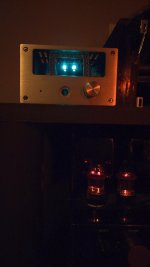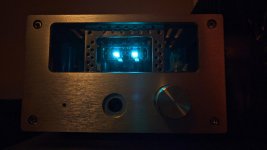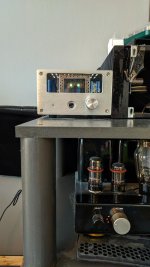If you put a volume pot after the Korg, you do have some control over the amount
of distortion, that is to say you can increase it, as it goes up with level before the
pot. If you put gain after the Korg, or use an amplifier with more gain, you will
decrease the distortion.
Could you please provide some more info on this option?
I am making a hybrid amplifier, that includes Nutube B1. There will be no volume control, so I will employ a voltage divider. The amplifier portion has 20+ dB of gain. Cosmetically speaking, I think having the divider directly between preamp and amp portions would be elegant design. Are you saying there is a sonic benefit to this variation?
Thank you
Last edited:
The B1K article indicates that he designed the distortion profile around a 1V output. Distortion increases with output voltage. So in theory running 1V through it and placing the volume control downstream adds more control and meets the ideal design criteria. However, real music is dynamic so it’s unclear how much benefit it would actually provide.
Hi Irishpatrick,
Yes, R1 and R2 are as you stated.
R2 goes to signal ground, idealy the one at the input.
I hope this helps
Claude
Yes, R1 and R2 are as you stated.
R2 goes to signal ground, idealy the one at the input.
I hope this helps
Claude
Here is my attempt. Was pretty easy to dial in the 9.5 V om T7 and T8 (after flushing all the solder points). I used velcro to dampen the piece of plexy glass it is glued to, behind the front front plexy glass. I can still hear some microphonics, but only when smashing two pieces of wooden toys together, which happens surprisingly frequently in my home.
Sound is warm and open, but the tube saturation is more towards a fuzz guitar pedal than a tube preamp. I use it with an F5 amplifier, and it has never sounded better. I used a B1 preamp before, which now is used with an integrated Sun Audio 2A3 replica amp. This gave me the opportunity to try the Sun Audio amp on max volume with B1 as a volume control, and it became overwhelmingly FAT! Had to tone it down a little. I use the B1 + tube amp on 15" JBL woofers, and the B1 Triode + F5 on my mid and high horns. All I can say it is that it is better than before, but I wonder if I should use a real tube preamp with the F5. I thought the Sun Audio replica amp is too imprecise for mid-range, here the F5 is more accurate, but the F5 was always it bit hard sounding, but not any more thanks the B1 Triode. I may add some decorative flourescent volt meters for T7 and T8 in the future, with an off switch, just to fill that empty hole in the middle of the chassis.
Sound is warm and open, but the tube saturation is more towards a fuzz guitar pedal than a tube preamp. I use it with an F5 amplifier, and it has never sounded better. I used a B1 preamp before, which now is used with an integrated Sun Audio 2A3 replica amp. This gave me the opportunity to try the Sun Audio amp on max volume with B1 as a volume control, and it became overwhelmingly FAT! Had to tone it down a little. I use the B1 + tube amp on 15" JBL woofers, and the B1 Triode + F5 on my mid and high horns. All I can say it is that it is better than before, but I wonder if I should use a real tube preamp with the F5. I thought the Sun Audio replica amp is too imprecise for mid-range, here the F5 is more accurate, but the F5 was always it bit hard sounding, but not any more thanks the B1 Triode. I may add some decorative flourescent volt meters for T7 and T8 in the future, with an off switch, just to fill that empty hole in the middle of the chassis.
Attachments
Last edited:
Hello rewind,
nice work!
Now you can play going up and down around the 9.5V,
Invert your loudspeaker polarity - interesting results....
Can sound better or worse,
Greets
Dirk
nice work!
Now you can play going up and down around the 9.5V,
Invert your loudspeaker polarity - interesting results....

Can sound better or worse,
Greets
Dirk
The speaker cables are already reversed.
I can try the magnets and see what happens. How big magnets are needed? Fridge magnets or 200 gram neodymium?
I can try the magnets and see what happens. How big magnets are needed? Fridge magnets or 200 gram neodymium?
I use the B1 + tube amp on 15" JBL woofers, and the B1 Triode + F5 on my mid and high horns.
Interesting thing I ran into back in the 70's. JBL speakers (at least the D Series) were reverse phase compared to almost all other speakers. When you put a positive Voltage on the Red terminal, the cone pulls air away from the listener. Doesn't this mean you don't need to reverse speaker connections when using the B1K, H2 or ACA if you are using JBL's ???
Interesting thing I ran into back in the 70's. JBL speakers (at least the D Series) were reverse phase compared to almost all other speakers. When you put a positive Voltage on the Red terminal, the cone pulls air away from the listener. Doesn't this mean you don't need to reverse speaker connections when using the B1K, H2 or ACA if you are using JBL's ???
Red negative is an old JBL standard from their early movie theater days. Not all JBL product is red negative. Since some amplifiers might also invert polarity (admittedly a rare thing) the easiest way to ensure you know your polarity is to use the free Audio Control Mobile Tools smart phone app. It has a polarity tester app. You hook the line level out from your smart phone to your preamp input, it puts out a fairly quiet, soft intermittant "popping" sound which your smart phone mic picks up and the app displays the system polarity on screen. Way cool!
I am not using the B1 Triode with the JBL 15" midwoofer. But it has been a while since I read the B1 and F5 article. Maybe they have reversed speaker outputs as well.
They shouldn't. Neither the B1 or F5 invert polarity. It's the "K" component of the B1K that accounts for the inversion.
With B1K, I found that the pot value was a more important variable than the make and model of pot. I tried several different makes of 50K vs several different 20K and found I much prefer a 20K over a 50K pot with this preamp. 20K took out any residual shrillness. This may be due to the loading on my source and the resultant differences in noise and transient response and how those are amplified by the Korg. But I found 20K works for me.
Yes, I just switched from 50K Tocos Cosmos to 25K PEC pots. Sound is definitely less shrill and smoother. Not sure if it's the pot value or the pot itself. The cosmos are a little more 3D and technicolor. The PEC, a little less 3D but more natural in timbre and easier to listen to long term.
I have been thinking about the Korg B1 a lot. I have built 4 or 5 solid state preamps. Single ended and push pull. 2nd harmonic dominant and 3rd harmonic dominant. Difference exist. But they are more similar than different when compared to the Korg.
The Korg is in a different universe. Almost technicolor or supernatural compared to the others.
Interesting... I am a bit lazy and anyway very happy as things are, but I would be tempted "perhaps one day" to try my reference "resistor setup" at 20k vs the one I built at 50k to confirm or infirm impedanc value overtakes pot quality... at least in my system, as I understand this could be very system dependant (as shrillness might also be due to conventional LS...).
I couldn't find a Tocos at 20k but TBH I remember reading here one of the members had adverse problems at 20k or lower and prefered 50k, much safer, so it might indeed be very system dependent.
Has anyone tried 10k?
For whatever it is worth, there is a 10k version of the Tocos stereo pot I use, at the same non expensive price... no clue though how it sounds as I went 50k. That is the next value up, but you could have 2 mono 20k pots for those wanting balance and 20k. Again, was put off by some posts saying too low a value wouldn't be good or bring any benefit (other than a very theoretical lower noise).
There is no shrillness in my case, perhaps I am lucky: my Tocos vs a "perfect reference" (as pure and direct as it gets, see my posts) sounds nearly identical bare perhaps a (very small) tad less energy in the low bass region, on impulses mainly. As I know it (LOL) I wish I could do something about it, but on the other hand I must say my B1K isn't bass shy, so... I just enjoy it the way it is 🙂
Again, all this is nick picking: 3D image, musicality, frequence response and neutrality while having nonetheless "that addictive sound" (that small addition that fools my brain?) makes my B1K really very very special and very enjoyable - and that with the Tocos and the PPP caps. Hmm, speaking of synergy... is the shrillness some experience still there after fitting PPP caps? Just thinking loud... Perhaps there are different synergies re cap and pot combos...
Have fun
Claude
I couldn't find a Tocos at 20k but TBH I remember reading here one of the members had adverse problems at 20k or lower and prefered 50k, much safer, so it might indeed be very system dependent.
Has anyone tried 10k?
For whatever it is worth, there is a 10k version of the Tocos stereo pot I use, at the same non expensive price... no clue though how it sounds as I went 50k. That is the next value up, but you could have 2 mono 20k pots for those wanting balance and 20k. Again, was put off by some posts saying too low a value wouldn't be good or bring any benefit (other than a very theoretical lower noise).
There is no shrillness in my case, perhaps I am lucky: my Tocos vs a "perfect reference" (as pure and direct as it gets, see my posts) sounds nearly identical bare perhaps a (very small) tad less energy in the low bass region, on impulses mainly. As I know it (LOL) I wish I could do something about it, but on the other hand I must say my B1K isn't bass shy, so... I just enjoy it the way it is 🙂
Again, all this is nick picking: 3D image, musicality, frequence response and neutrality while having nonetheless "that addictive sound" (that small addition that fools my brain?) makes my B1K really very very special and very enjoyable - and that with the Tocos and the PPP caps. Hmm, speaking of synergy... is the shrillness some experience still there after fitting PPP caps? Just thinking loud... Perhaps there are different synergies re cap and pot combos...
Have fun
Claude
Last edited:
I am hearing ringing every time someone clap hands or small object lands on the floor, or I just play too loud music. It was intruiging at first but now it is starting to annoy me.
Can it be the Nutube picking up sounds from my speakers, like using the speaker diaphragm as the diaphragm of a microphone, or do I just need to dampen the nutube better? The whole preamp is on a thick rubber pad and the nutube is attached with double sided velcro.
Can it be the Nutube picking up sounds from my speakers, like using the speaker diaphragm as the diaphragm of a microphone, or do I just need to dampen the nutube better? The whole preamp is on a thick rubber pad and the nutube is attached with double sided velcro.
I’m using a 10k and have not tried anything else. So that is not a good help. I, on the other hand, am a bit curious how it would be with a 50k. My system is the best I’ve done so far,
B1K-F4. The urge to try more is overwhelming.
B1K-F4. The urge to try more is overwhelming.
I am hearing ringing every time someone clap hands or small object lands on the floor, or I just play too loud music. It was intruiging at first but now it is starting to annoy me.
Can it be the Nutube picking up sounds from my speakers, like using the speaker diaphragm as the diaphragm of a microphone, or do I just need to dampen the nutube better? The whole preamp is on a thick rubber pad and the nutube is attached with double sided velcro.
Sounds like microphonics from the tube - this is caused by vibration affecting the nutube, nothing to do with the speaker diaphragm).
Some people have had success calming the vibrations with magnets, others with a variety of mounting methods.
Have you mounted the PCB-to-chassis with anti-vibration mounts? That can help quite a bit.
Or buy two single supply boards at lower price and bigger heat sink.
Linear Power Supply board MJE15034G Low noise 5V a 24V 2A - Audiophonics
No. I will try AD817 & AD825 later, but before I can do that I'll need to modify the board (remove fine tune opamp). Also I will need better measurement equipment to see the difference.
The major reason I ordered OPA2314 is to lower opamp supply rail to ~5.5V so I can use 7V transformer. Less heat across pass transistor @ high current, right now when drive 5V load @ 1A, the hottest spot at the heat sink is about 70C.
Any suggestion for opamps to try? regardless BJT or FET input.
Have u build a tube preamp? Spent alot on one single clone and never regretted. It's special.Yes, I just switched from 50K Tocos Cosmos to 25K PEC pots. Sound is definitely less shrill and smoother. Not sure if it's the pot value or the pot itself. The cosmos are a little more 3D and technicolor. The PEC, a little less 3D but more natural in timbre and easier to listen to long term.
I have been thinking about the Korg B1 a lot. I have built 4 or 5 solid state preamps. Single ended and push pull. 2nd harmonic dominant and 3rd harmonic dominant. Difference exist. But they are more similar than different when compared to the Korg.
The Korg is in a different universe. Almost technicolor or supernatural compared to the others.
I am hearing ringing every time someone clap hands or small object lands on the floor, or I just play too loud music. It was intruiging at first but now it is starting to annoy me.
Can it be the Nutube picking up sounds from my speakers, like using the speaker diaphragm as the diaphragm of a microphone, or do I just need to dampen the nutube better? The whole preamp is on a thick rubber pad and the nutube is attached with double sided velcro.
Some of the NuTube triodes ring very easily from mechanical vibrations transmitted through the chassis and standoffs, and some through sound waves impacting the glass envelope of the NuTube. Using vibration damping/isolating rubber/metal standoffs cured most of the problem. The other part is to use an enclosure with no vents that should probably be dampened with mass loaded vibration damping sheets applied to the internal sides and top of the enclosure. Once you take care of the microphony, you will be amazed at the level of sound quality from this preamp.
My friend in California who borrowed my B1 Korg after the Burning Amp Fest returned it to me, so now I am on to installing film caps and the Tocos Cosmos 50k stereo volume pot. Can’t wait to hear the results. The stock unit from the Conpletion Kit is impressive itself.
I have a TKD exspensive pot. It is 50 kohm. I thought I will solder 47 kohm across it. So I will get approx 28 kohm but will it work?
- Home
- Amplifiers
- Pass Labs
- B1 with Korg Triode


